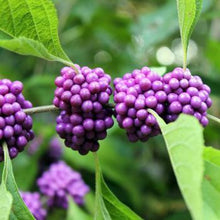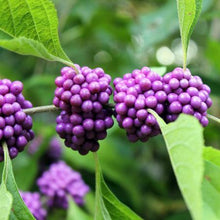The American Beautyberry is an extraordinary shrub.
The deciduous Perennial comes alive in April with toothed green foliage. Then, in July it produces small white and pink flowers in clusters. Undoubtedly, the most impressive time of year for this plant is September, when bright, iridescent purple berries emerge and continue to blossom through November.
In addition to the ever-changing appearance throughout the year, there are some astonishing advantages to owning this plant.
Natural Mosquito Repellent
The US Department of Agriculture Research Service has confirmed that the Beautyberry leaves contain three compounds that are responsible for repelling mosquitoes and other biting bugs, including fire ants.
It has been said that all you need to do is grab a few leaves, and crush them in your hands and rub them on your skin. What a great way to save money.
This chemical-free solution to keep insects from landing and biting is something our forefathers have known for generations.
In the early 20th Century, farmers crushed the leaves and placed them in between their horse and its harness to keep mosquitoes and ticks away. Perhaps they learned this from early Native Americans who found many medicinal uses for the plants. For centuries, the roots, leaves, berries and stems of these plants were used by many Native American Tribes for medicinal purposes. Different parts of the shrub are believed to be natural cures for fevers, malaria, rheumatism, stomach aches and colic.
So Versatile: They Can be Grown as Trees, Shrubs or Container Plants
No matter where you plant your Beautyberries, they’re destined to thrive and enhance your setting.
You can plant several together for an expansive naturalized section of your landscape if you have a lot of land. Planted in multiples, they provide a colorful display of fragrant flowers before producing plump, vibrant purple berries.
Plant one or two to compliment a mixed border, or plant one and let it grow as an ornamental plant. They also do very well in containers!
Plant These Low Maintenance Beauties and 'Forget About It'
Despite how you prune them, or where you place them, the American Beautyberries are easy to maintain. They grow best in moist, rich soils, and do well in sandy, sandy loam and clay. We recommend you prune once in the fall, and again right before new growth begins in the spring. Then watch them take off!
- They’re heat tolerant, able to survive the harshest of droughts
- Insect and Pest Resistant
- Disease Resistant
Edible Berries Attract Wildlife Year-round
White-tailed deer are drawn to the berries in the fall after the leaves have dropped. There are over 40 species of songbirds that are attracted to these plants for the nectar. Cattle like to browse the twigs during the cold months.
If you enjoy watching wildlife, these plants will likely be a wonderful source of entertainment!
Will YOU like the berries? They’re not known to be particularly tasty if eaten right from the plant itself but are delicious in jellies and American Beautyberry wine. If you have some recipes that include these berries, we’d love to hear about them.
Order now and brighten up your landscape year after year with this lovely bush.
Planting & Care
You can plant in the spring or fall. You should plant your American Beautyberry in an area with light shade. If you’re planting multiple bushes, they should be spaced 4’ to 6’ apart to allow plenty of room for growth.
Place the tree in a hole that’s only as deep as the root and 2-3 times as wide. You should fill the hole half-way with soil, then water it and wait for it to drain before filling it with the rest of the soil.
These do well in most types of soil conditions but grow best in moist soil. Beautyberry bushes are drought tolerant, but in cases of extreme drought, should be watered. They need about an inch of rain per week.



